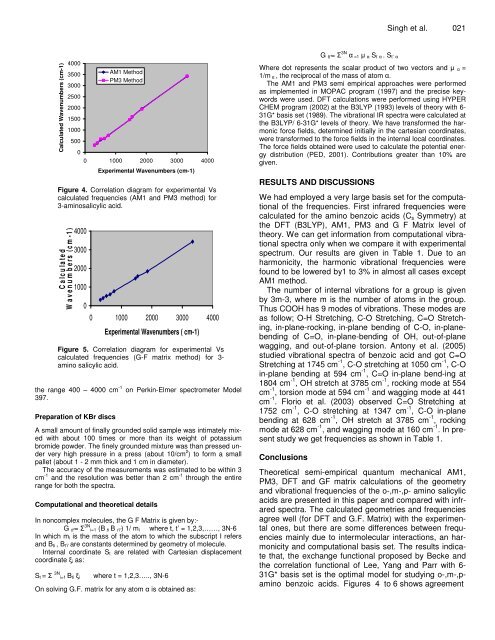Numerical simulation of the internal vibrations of COOH group in ...
Numerical simulation of the internal vibrations of COOH group in ...
Numerical simulation of the internal vibrations of COOH group in ...
You also want an ePaper? Increase the reach of your titles
YUMPU automatically turns print PDFs into web optimized ePapers that Google loves.
Calculated Wavenumbers (cm-1)<br />
4000<br />
3500<br />
3000<br />
2500<br />
2000<br />
1500<br />
1000<br />
500<br />
0<br />
AM1 Method<br />
PM3 Method<br />
0 1000 2000 3000 4000<br />
Experimental Wavenumbers (cm-1)<br />
Figure 4. Correlation diagram for experimental Vs<br />
calculated frequencies (AM1 and PM3 method) for<br />
3-am<strong>in</strong>osalicylic acid.<br />
C a lc u la t e d<br />
W a v e n u m b e r s ( c m - 1 )<br />
4000<br />
3000<br />
2000<br />
1000<br />
0<br />
0 1000 2000 3000 4000<br />
Experimental Wavenumbers ( cm-1)<br />
Figure 5. Correlation diagram for experimental Vs<br />
calculated frequencies (G-F matrix method) for 3am<strong>in</strong>o<br />
salicylic acid.<br />
<strong>the</strong> range 400 – 4000 cm -1 on Perk<strong>in</strong>-Elmer spectrometer Model<br />
397.<br />
Preparation <strong>of</strong> KBr discs<br />
A small amount <strong>of</strong> f<strong>in</strong>ally grounded solid sample was <strong>in</strong>timately mixed<br />
with about 100 times or more than its weight <strong>of</strong> potassium<br />
bromide powder. The f<strong>in</strong>ely grounded mixture was than pressed under<br />
very high pressure <strong>in</strong> a press (about 10/cm 2 ) to form a small<br />
pallet (about 1 - 2 mm thick and 1 cm <strong>in</strong> diameter).<br />
The accuracy <strong>of</strong> <strong>the</strong> measurements was estimated to be with<strong>in</strong> 3<br />
cm -1 and <strong>the</strong> resolution was better than 2 cm -1 through <strong>the</strong> entire<br />
range for both <strong>the</strong> spectra.<br />
Computational and <strong>the</strong>oretical details<br />
In noncomplex molecules, <strong>the</strong> G F Matrix is given by:-<br />
G tt’= 3N i=1 (B ti B t’i’) 1/ mi where t, t’ = 1,2,3,……, 3N-6<br />
In which mi is <strong>the</strong> mass <strong>of</strong> <strong>the</strong> atom to which <strong>the</strong> subscript I refers<br />
and Bti , Bt’i’ are constants determ<strong>in</strong>ed by geometry <strong>of</strong> molecule.<br />
Internal coord<strong>in</strong>ate St are related with Cartesian displacement<br />
coord<strong>in</strong>ate i as:<br />
St = 3N i=1 Bti i where t = 1,2,3….., 3N-6<br />
On solv<strong>in</strong>g G.F. matrix for any atom is obta<strong>in</strong>ed as:<br />
G tt’= 3N =1 St . St’<br />
S<strong>in</strong>gh et al. 021<br />
Where dot represents <strong>the</strong> scalar product <strong>of</strong> two vectors and =<br />
1/m , <strong>the</strong> reciprocal <strong>of</strong> <strong>the</strong> mass <strong>of</strong> atom .<br />
The AM1 and PM3 semi empirical approaches were performed<br />
as implemented <strong>in</strong> MOPAC program (1997) and <strong>the</strong> precise keywords<br />
were used. DFT calculations were performed us<strong>in</strong>g HYPER<br />
CHEM program (2002) at <strong>the</strong> B3LYP (1993) levels <strong>of</strong> <strong>the</strong>ory with 6-<br />
31G* basis set (1989). The vibrational IR spectra were calculated at<br />
<strong>the</strong> B3LYP/ 6-31G* levels <strong>of</strong> <strong>the</strong>ory. We have transformed <strong>the</strong> harmonic<br />
force fields, determ<strong>in</strong>ed <strong>in</strong>itially <strong>in</strong> <strong>the</strong> cartesian coord<strong>in</strong>ates,<br />
were transformed to <strong>the</strong> force fields <strong>in</strong> <strong>the</strong> <strong><strong>in</strong>ternal</strong> local coord<strong>in</strong>ates.<br />
The force fields obta<strong>in</strong>ed were used to calculate <strong>the</strong> potential energy<br />
distribution (PED, 2001). Contributions greater than 10% are<br />
given.<br />
RESULTS AND DISCUSSIONS<br />
We had employed a very large basis set for <strong>the</strong> computational<br />
<strong>of</strong> <strong>the</strong> frequencies. First <strong>in</strong>frared frequencies were<br />
calculated for <strong>the</strong> am<strong>in</strong>o benzoic acids (Cs Symmetry) at<br />
<strong>the</strong> DFT (B3LYP), AM1, PM3 and G F Matrix level <strong>of</strong><br />
<strong>the</strong>ory. We can get <strong>in</strong>formation from computational vibrational<br />
spectra only when we compare it with experimental<br />
spectrum. Our results are given <strong>in</strong> Table 1. Due to an<br />
harmonicity, <strong>the</strong> harmonic vibrational frequencies were<br />
found to be lowered by1 to 3% <strong>in</strong> almost all cases except<br />
AM1 method.<br />
The number <strong>of</strong> <strong><strong>in</strong>ternal</strong> <strong>vibrations</strong> for a <strong>group</strong> is given<br />
by 3m-3, where m is <strong>the</strong> number <strong>of</strong> atoms <strong>in</strong> <strong>the</strong> <strong>group</strong>.<br />
Thus <strong>COOH</strong> has 9 modes <strong>of</strong> <strong>vibrations</strong>. These modes are<br />
as follow; O-H Stretch<strong>in</strong>g, C-O Stretch<strong>in</strong>g, C=O Stretch<strong>in</strong>g,<br />
<strong>in</strong>-plane-rock<strong>in</strong>g, <strong>in</strong>-plane bend<strong>in</strong>g <strong>of</strong> C-O, <strong>in</strong>-planebend<strong>in</strong>g<br />
<strong>of</strong> C=O, <strong>in</strong>-plane-bend<strong>in</strong>g <strong>of</strong> OH, out-<strong>of</strong>-plane<br />
wagg<strong>in</strong>g, and out-<strong>of</strong>-plane torsion. Antony et al. (2005)<br />
studied vibrational spectra <strong>of</strong> benzoic acid and got C=O<br />
Stretch<strong>in</strong>g at 1745 cm -1 , C-O stretch<strong>in</strong>g at 1050 cm -1 , C-O<br />
<strong>in</strong>-plane bend<strong>in</strong>g at 594 cm -1 , C=O <strong>in</strong>-plane bend-<strong>in</strong>g at<br />
1804 cm -1 , OH stretch at 3785 cm -1 , rock<strong>in</strong>g mode at 554<br />
cm -1 , torsion mode at 594 cm -1 and wagg<strong>in</strong>g mode at 441<br />
cm -1 . Florio et al. (2003) observed C=O Stretch<strong>in</strong>g at<br />
1752 cm -1 , C-O stretch<strong>in</strong>g at 1347 cm -1 , C-O <strong>in</strong>-plane<br />
bend<strong>in</strong>g at 628 cm -1 , OH stretch at 3785 cm -1 , rock<strong>in</strong>g<br />
mode at 628 cm -1 , and wagg<strong>in</strong>g mode at 160 cm -1 . In present<br />
study we get frequencies as shown <strong>in</strong> Table 1.<br />
Conclusions<br />
Theoretical semi-empirical quantum mechanical AM1,<br />
PM3, DFT and GF matrix calculations <strong>of</strong> <strong>the</strong> geometry<br />
and vibrational frequencies <strong>of</strong> <strong>the</strong> o-,m-,p- am<strong>in</strong>o salicylic<br />
acids are presented <strong>in</strong> this paper and compared with <strong>in</strong>frared<br />
spectra. The calculated geometries and frequencies<br />
agree well (for DFT and G.F. Matrix) with <strong>the</strong> experimental<br />
ones, but <strong>the</strong>re are some differences between frequencies<br />
ma<strong>in</strong>ly due to <strong>in</strong>termolecular <strong>in</strong>teractions, an harmonicity<br />
and computational basis set. The results <strong>in</strong>dicate<br />
that, <strong>the</strong> exchange functional proposed by Becke and<br />
<strong>the</strong> correlation functional <strong>of</strong> Lee, Yang and Parr with 6-<br />
31G* basis set is <strong>the</strong> optimal model for study<strong>in</strong>g o-,m-,p-<br />
am<strong>in</strong>o benzoic acids. Figures 4 to 6 shows agreement

















